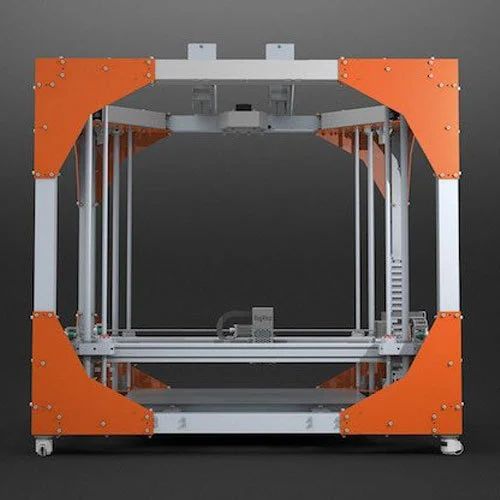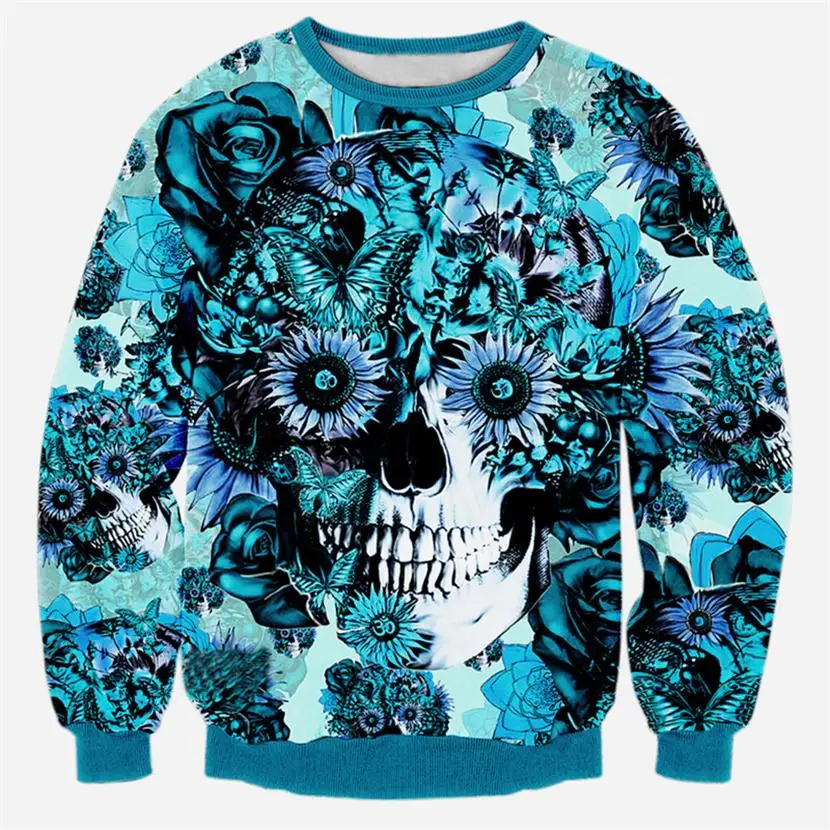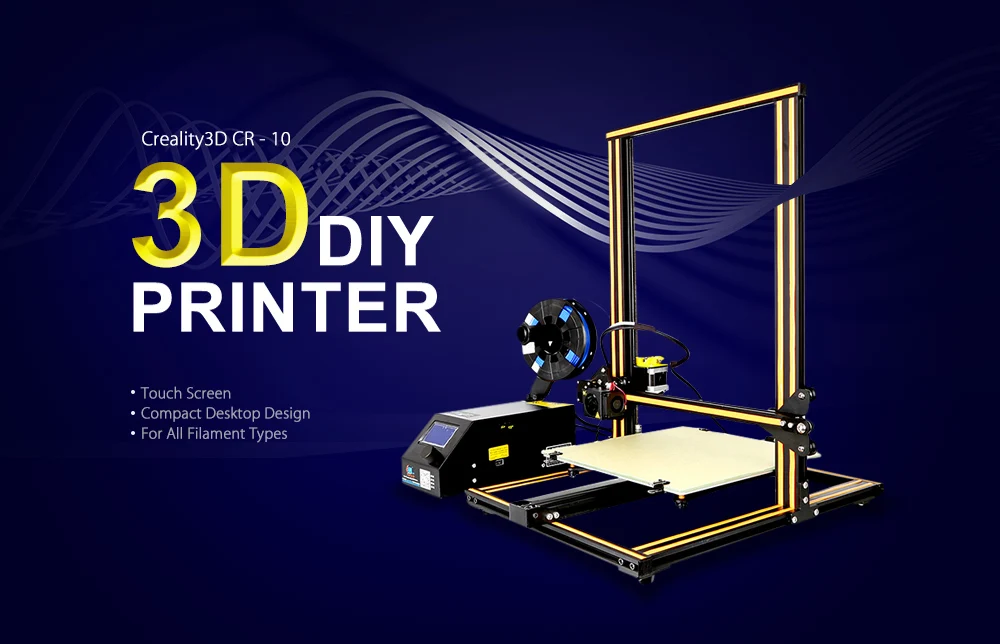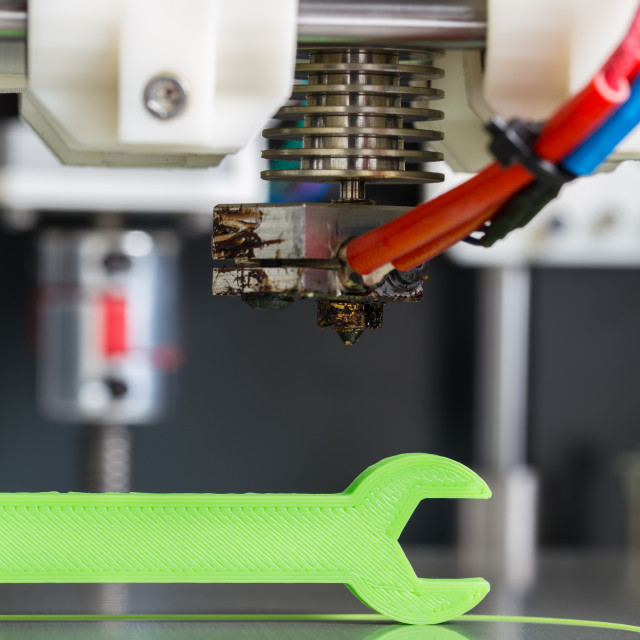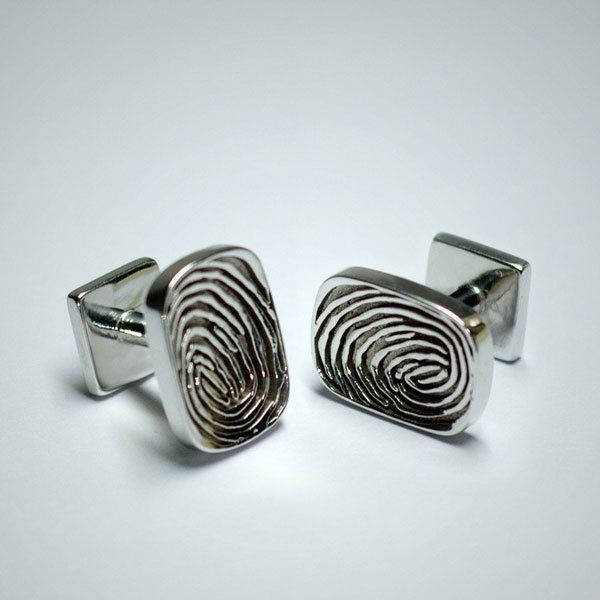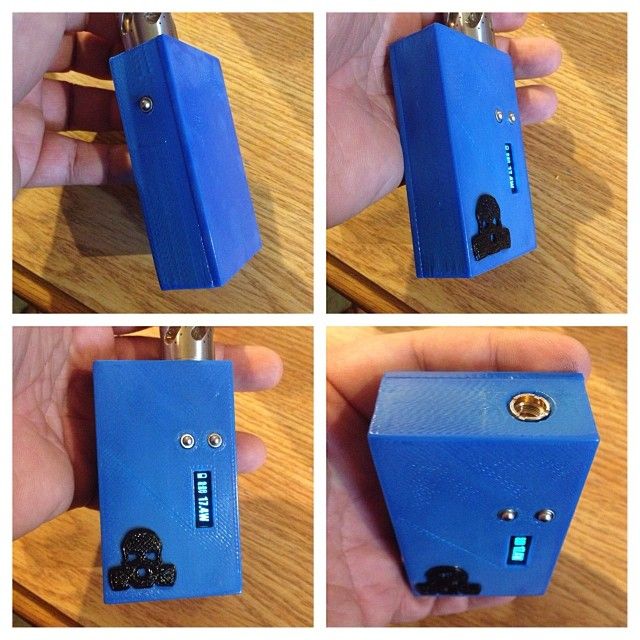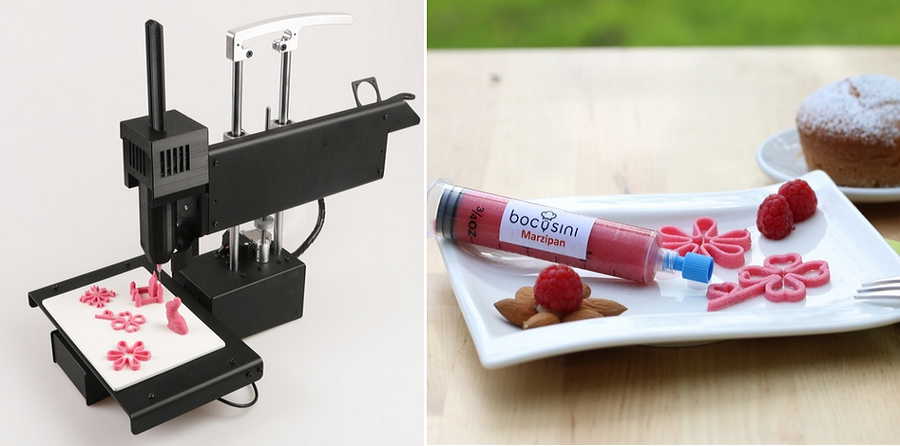Big rep 3d printer
Large-Format 3D Printers: Industrial & Professional
INTRODUCING THE NEW
ITERATE FAST.PRODUCE FASTER.
GET TO MARKET FASTEST.
Explore the PRO
INTRODUCING THE NEW
ITERATE FAST.
PRODUCE FASTER.
GET TO MARKET FASTEST.
Explore the PRO
Play Video
There was an opportunity to not only fill SAS's need for this tool they couldn't acquire through the normal supply chain, but we also saw the opportunity to make it better."
Nathan Brown, Managing Director at CNE Engineering
Read more about the case study here
BigRep makes big, industrial 3D printers for big, full-scale parts (and even big batches of smaller parts). Our commercial 3D printers are up to 1 m3 in build volume, which in fact is big enough to hold 2 baby elephants or equals the build volume of about 40 desktop printers!
With a large 3D printer, you can advance your manufacturing capabilities with 3D printed prototypes, jigs and fixtures, patterns and molds and end use parts. Where size isn’t a limiting factor, BigRep industrial 3D printers are built to make you faster and more agile, getting your products to market ahead of the competition.
ITERATE FAST. PRODUCE FASTER. GET TO MARKET FASTEST.
The BigRep PRO is a 1 m³ powerhouse 3D printer, built to take you from prototyping to production. It provides a highly scalable solution to manufacture end-use parts, factory tooling or more with high-performance, engineering-grade materials.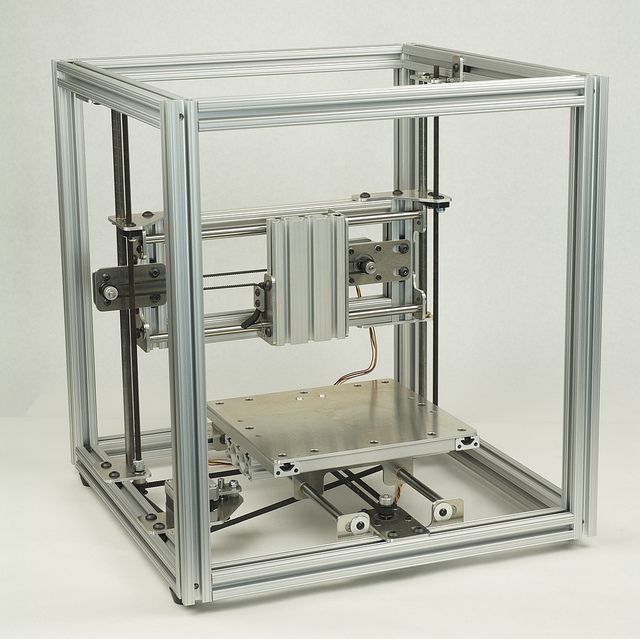 Compared with other manufacturing and FFF printing solutions, the PRO can produce full-scale, accurate parts faster and at lower production costs.
Compared with other manufacturing and FFF printing solutions, the PRO can produce full-scale, accurate parts faster and at lower production costs.
Explore the PRO
ITERATE FAST. PRODUCE FASTER. GET TO MARKET FASTEST.
The BigRep PRO is a 1 m³ powerhouse 3D printer, built to take you from prototyping to production. It provides a highly scalable solution to manufacture end-use parts, factory tooling or more with high-performance, engineering-grade materials. Compared with other manufacturing and FFF printing solutions, the PRO can produce full-scale, accurate parts faster and at lower production costs.
Explore the PRO
GRADUATE FROM DESKTOP. GET INDUSTRIAL.
The BigRep STUDIO G2 gets 3D printing off your desk and takes it to the next level. Operating with the same ease as a desktop 3D printer and with 10 times the build volume, the STUDIO G2 provides large-scale industrial manufacturing capabilities in a compact “fits everywhere” build.
Explore the STUDIO
GRADUATE FROM DESKTOP.
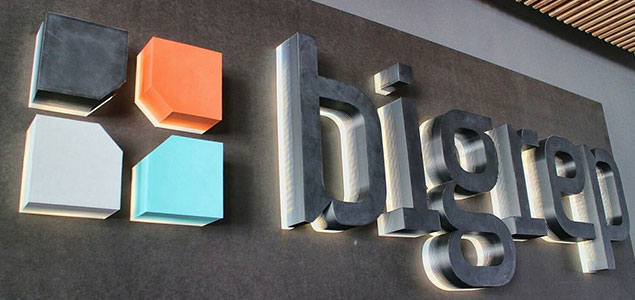 GET INDUSTRIAL.
GET INDUSTRIAL.The BigRep STUDIO G2 gets 3D printing off your desk and takes it to the next level. Operating with the same ease as a desktop 3D printer and with 10 times the build volume, the STUDIO G2 provides large-scale industrial manufacturing capabilities in a compact “fits everywhere” build.
Explore the STUDIO
LARGE-SCALE INNOVATION. LIMITLESS CREATIVITY.
The BigRep ONE is an award-winning, large-format 3D printer at an accessible price point. With over 500 systems installed worldwide, it's a trusted tool of designers, innovators, and manufacturers alike. With a massive one-cubic-meter build volume, the fast and reliable ONE brings your designs to life in full scale.
Explore the ONE
LARGE-SCALE INNOVATION. LIMITLESS CREATIVITY.
The BigRep ONE is an award-winning, large-format 3D printer at an accessible price point. With over 500 systems installed worldwide, it's a trusted tool of designers, innovators, and manufacturers alike. With a massive one-cubic-meter build volume, the fast and reliable ONE brings your designs to life in full scale.
With a massive one-cubic-meter build volume, the fast and reliable ONE brings your designs to life in full scale.
Explore the ONE
INDUSTRIAL 3D PRINTING MATERIALS
WIDE VARIETY
INDUSTRIAL QUALITY
LARGE-FORMAT OPTIMIZED
BigRep's portfolio of industrial 3D printing filaments are created under carefully controlled conditions to guarantee uniform diameters and consistent composition. They are sealed in controlled, low-humidity conditions for safe storage and transportation - ensuring reliable, even extrusion regardless of whether they're used today or after a reasonable shelf life.
With a wide variety of offerings from affordable, general use filaments to high-quality, engineering-grade materials for demanding industrial applications, BigRep has what you need - specialized for large-format 3D printing to bring your designs to life in full scale.
FIND YOUR FILAMENTS
INDUSTRIAL 3D PRINTING MATERIALS
WIDE VARIETY
INDUSTRIAL QUALITY
LARGE-FORMAT OPTIMIZED
BigRep's portfolio of industrial additive 3D printing filaments are created under carefully controlled conditions to guarantee uniform diameters and consistent composition. They are sealed in controlled, low-humidity conditions for safe storage and transportation - ensuring reliable, even extrusion regardless of whether they're used today or after a reasonable shelf life.
With a wide variety of offerings from affordable, general use filaments to high-quality, engineering-grade materials for demanding industrial applications, BigRep has was your need - specialized for large-format 3D printing to bring your designs to life in full-scale.
FIND YOUR FILAMENTS
INTRODUCING
A new customizable SaaS solution that makes application engineering for 3D printed jigs, fixtures, and manufacturing aids easier than ever, with no design skills or 3D printing experience required.
Learn More
INTRODUCING
A new customizable SaaS solution that makes application engineering for 3D printed jigs, fixtures, and manufacturing aids easier than ever, with no design skills or 3D printing experience required.
Learn More
Request Pricing or Talk to a 3D Printing ExpertHelp Us Understand Your Needs
REQUEST PRICING
Large Industrial 3D Printers - Large Format AM
BigRep's large 3D printers are your partner for industrial additive manufacturing, whether for functional rapid prototyping, tooling, or end products.
The industrial 3D printers offer a number of state-of-the-art features that enable a wide range of professional applications. Benefit from expert advice on your 3D printer purchase and the wide selection of 3D printing filaments.
ITERATE FAST. PRODUCE FASTER. GET TO MARKET FASTEST.
The BigRep PRO is a 1 m³ powerhouse 3D printer, built to take you from prototyping to production.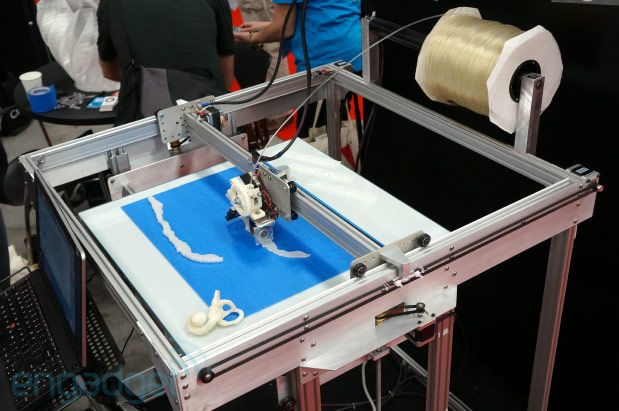 It provides a highly scalable solution to manufacture end-use parts, factory tooling or more with high-performance, engineering-grade materials. Compared with other manufacturing and FFF printing solutions, the PRO can produce full-scale, accurate parts faster and at lower production costs.
It provides a highly scalable solution to manufacture end-use parts, factory tooling or more with high-performance, engineering-grade materials. Compared with other manufacturing and FFF printing solutions, the PRO can produce full-scale, accurate parts faster and at lower production costs.
Explore the PRO
ITERATE FAST. PRODUCE FASTER. GET TO MARKET FASTEST.
The BigRep PRO is a 1 m³ powerhouse 3D printer, built to take you from prototyping to production. It provides a highly scalable solution to manufacture end-use parts, factory tooling or more with high-performance, engineering-grade materials. Compared with other manufacturing and FFF printing solutions, the PRO can produce full-scale, accurate parts faster and at lower production costs.
Explore the PRO
GRADUATE FROM DESKTOP. GET INDUSTRIAL.
The BigRep STUDIO G2 gets 3D printing off your desk and takes it to the next level. Operating with the same ease as a desktop 3D printer and with 10 times the build volume, the STUDIO G2 provides large-scale industrial manufacturing capabilities in a compact “fits everywhere” build.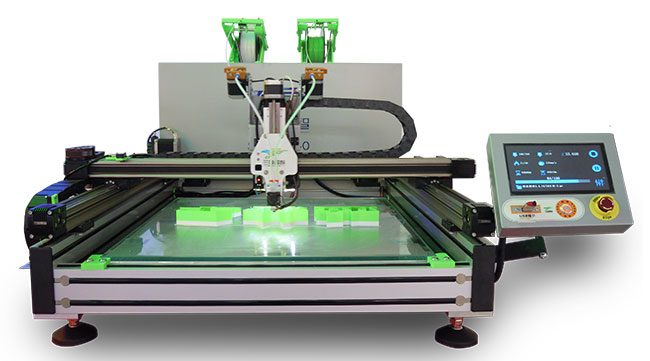
Explore the STUDIO
GRADUATE FROM DESKTOP. GET INDUSTRIAL.
The BigRep STUDIO G2 gets 3D printing off your desk and takes it to the next level. Operating with the same ease as a desktop 3D printer and with 10 times the build volume, the STUDIO G2 provides large-scale industrial manufacturing capabilities in a compact “fits everywhere” build.
Explore the STUDIO
LARGE-SCALE INNOVATION. LIMITLESS CREATIVITY.
The BigRep ONE is an award-winning, large-format 3D printer at an accessible price point. With over 500 systems installed worldwide, it's a trusted tool of designers, innovators, and manufacturers alike. With a massive one-cubic-meter build volume, the fast and reliable ONE brings your designs to life in full scale.
Explore the ONE
LARGE-SCALE INNOVATION. LIMITLESS CREATIVITY.
The BigRep ONE is an award-winning, large-format 3D printer at an accessible price point. With over 500 systems installed worldwide, it's a trusted tool of designers, innovators, and manufacturers alike. With a massive one-cubic-meter build volume, the fast and reliable ONE brings your designs to life in full scale.
With a massive one-cubic-meter build volume, the fast and reliable ONE brings your designs to life in full scale.
Explore the ONE
Request Pricing or Talk to a 3D Printing ExpertHelp Us Understand Your Needs
REQUEST PRICING
What is 3D Printing?
3D printing, also called additive manufacturing (AM), is a technology used to manufacture three-dimensional objects. 3D printers usually use plastic polymer materials (but also occasionally metal) and form objects by adhering layers to each other in succession.
Like many other manufacturing technologies, a 3D printer’s production is mapped with computer-aided designs, or CAD models. Digital models are “sliced” by specialized 3D printing software (called slicers) into individual layers and accompanying support structures, then printed.
How does a 3D Printer work?How a 3D printer works depends on the specific technology it employs, the most common being FFF (FDM), SLA, and SLS in that order.
1
FFF - Fused Filament FabricationFused Filament Fabrication (FFF), also commonly known by its trademarked name; Fused Deposition Modeling (FDM), works by depositing molten filament on top of itself in individual layers until the desired object’s final geometry is formed. FFF is the most common – and usually most affordable – form of additive manufacturing technology available today.
In FFF 3D printing, polymer filament is pushed through an extruder that melts the material at a hot-end – similar to a hot-glue gun pushing solid glue sticks through its hot nozzle. The polymer material is then “printed” in layers as it is pushed through its nozzle, the diameter of which determines the layer size, and deposited onto a build platform (or “print bed”) or preceding layers.
There is usually minimal post-processing required for parts printed with FFF technology beyond support structure removal – if they were necessary at all.
What are some features of an FFF 3D printer?
- Usually fastest of common 3D printing technologies
- Lowest cost in both purchase price and consumables
- Extremely easy post-processing and minimal cleanup
2
SLA - StereolithographyStereolithography (SLA), the second most common additive manufacturing technology, works by curing liquid resin to itself in successive layers to form the desired object.
In SLA 3D printing, a build platform is lowered into a tray of liquid resin where it compresses the material against the bottom of a transparent tray before being cured by a mirrored UV laser. The process repeats, pushing each previous layer against the bottom of the tray until complete.
SLA is capable of incredibly detailed parts but is a material-intensive process. Significantly more of the resin material is normally required than the final object demands for the process to be effective. With excess material usually left in the tray, failed prints risk contamination. Dedicated trays are usually required for each liquid resin – which are themselves consumable as they are worn by light exposure from the UV laser.
What are some features of an SLA 3D printer?
- Capable of very small layer sizes for intricate model details
- Time-consuming process, increased exponentially with smaller layers
- Requires heavy clean up and post-processing with additional curing
3
SLS - Selective Laser SinteringSelective Laser Sintering (SLS) works by curing powdered material in successive layers as it is repeatedly spread throughout a build volume until the final object is formed. It is significantly less common than the other plastic technologies listed here, but is commonly used in metal additive manufacturing.
It is significantly less common than the other plastic technologies listed here, but is commonly used in metal additive manufacturing.
Similarly to SLA technology, the SLS process requires an abundance more material than is used to form the final object. However, there is little chance of material contamination and the required excess material serves a secondary purpose as a natural support structure.
Because SLS uses its powder material as a support for printed objects, it requires virtually no post-processing after the print has completed. It is capable of intricate detail but is a relatively slow and expensive process.
What are some features of an SLS 3D printer?
- No post-processing required since excess material serves as supports
- Typically the most expensive of the common 3D printing technologies
- Time-consuming process, increased exponentially with smaller layers
DESIGN
3D printed objects are designed with computer-aided design software (CAD). Knowledgeable designers and engineers use CAD software to form entirely new designs, or use 3D scanners to capture real-world objects digitally. Increasingly, artificial intelligence and parametric design software is used to automate design processes.
Knowledgeable designers and engineers use CAD software to form entirely new designs, or use 3D scanners to capture real-world objects digitally. Increasingly, artificial intelligence and parametric design software is used to automate design processes.
3D PRINT
To be 3D printed CAD models must be broken down into individual layers and the printing process mapped with slicing software (or “slicers”). Slicers generate G-code, a computer-aided manufacturing control language, from CAD models that directs a 3D printer’s movements as it recreates the digital model as a physical object.
POST PROCESS
Depending on your design and 3D printing technology, you’ll likely want to improve your print with some post-processing. Post-processing is anything that is done to an object after the 3D printer has finished producing it. Additional curing, support removal, sanding, painting and other coatings are all examples of common post-processing used to achieve a perfect, final 3D printed object.
Advantages of 3D Printing
3D printing offers many advantages over traditional manufacturing technologies. As a uniquely disruptive technology, businesses who invest in additive manufacturing are rewarded with exceptional efficiencies in their production. As 3D printing methods improve and new polymer materials with increased capabilities are introduced to the ever-growing additive manufacturing market, the technology’s possible applications continue to increase exponentially.
3D printers work exceptionally fast to produce impressive, geometrically complex objects – often in a matter of hours, depending on the size.
Traditional manufacturing methods are notorious for long lead times that hold up dependent workflows, often for weeks at a time. As a highly reliable unattended process, 3D printing can produce even full scale objects overnight to be ready for use the next day.
FLEXIBILITY
Because 3D printing uses digital files (CAD models) instead of physical tooling like patterns and molds, it’s a highly flexible technology.
Small series or 100% personalized manufacturing and design processes with many iterations benefit greatly in both speed and cost when compared to traditional manufacturing processes that require manually machined tooling to operate.
Manufacturing costs can be determined by three metrics - material, operating and labor expenses. Unlike wasteful reductive manufacturing techniques, 3D printing is an “additive” process that uses just enough material to produce an object.
As a single unattended process, operating and labor expenses are eliminated by a consolidated process that frees staff for other tasks. Since 3D printers don’t require object-specific tooling, manufacturers also save whenever implementing product changes.
ENVIRONMENTALLY FRIENDLY
Though some forms of 3D printing are more ecological than others, the nature of additive manufacturing technologies – which use just enough material to produce an object – make them all significantly more environmentally friendly than reductive techniques.
In FFF 3D printing “closed-loop” material processes are becoming increasingly common, where polymer shredders are used to recycle filament in-house to be reused in the 3D printing process.
Advantages of Industrial 3D PrintersWith industrial 3D printers you can create functional, full-scale objects or industrial parts beyond the limitations of more standard build volumes.
In smaller build sizes large-format parts must be divided before slicing, printed separately and adhered together in an imperfect manual process. By manufacturing in full scale, you save time by not only avoiding multiple print jobs and post-processing, but also make parts exceptionally stronger. Objects printed with industrial 3D printers are often highly functional parts ranging from end-use products like furniture and recreational vehicles to high-strength industrial tooling.
What is a
large-format 3D Printer used for?3D printers are used for a wide variety of applications, with more becoming a reality every day. The three most common additive manufacturing applications are…
The three most common additive manufacturing applications are…
Increasingly, 3D printers are being used to create end-use parts and even consumer products. Because of the flexibility inherent in additive manufacturing, businesses offering highly personalized products have been using additive manufacturing to create small series or completely unique products for a long time. Today, even industrial manufacturers use 3D printing for serial production and to create affordable, industrial parts.
Tooling / FixturesThough 3D printers don’t require any tooling themselves, they’re fantastic at producing it. Manufacturers can use 3D printing technology to create molds, patterns, or even jigs and fixtures to aid other manufacturing processes.
Unlike traditional tooling production, which usually requires excessive lead times, creating tooling with 3D printing is a fast and simple process. Even larger tooling can be additively manufacturing in an unattended process and be quickly in use on the factory floor.
Because 3D printers can manufacture objects so quickly without specially designed tooling, it’s widely recognized as an ideal technology for product development. Products can be manufactured and redesigned at incredible speed allowing designers to create more iterations and perfect their product.
Later in the design process, the same technology and design files can be used to create functional prototypes, allowing a team to experience their product in the real world.
3D-Printer FAQ
What is considered a large 3D printer?
Large 3D printers are too big to fit on a desk and usually offer a build volume bigger than 500x500x500 mm.
Small or large 3D printers can be sorted into two categories:
- Desktop 3D printers
- Large-format 3D printers
BigRep 3D printers provide a build volume of up to 1000x1000x1000 mm.
Which 3D printer has the biggest bed size?
With serial production 3D printers the print bed size can be up to 1000x1000 mm like in the BigRep PRO.
However, there is no real limit to bed sizes as there are custom made 3D printers like the University of Maine's 100 feet (30,5 m) long printer.
Can you 3D print large objects?
The size of a 3D printed object depends on the size of the 3D printer. With a BigRep ONE you can 3D print large objects up to 1000x1000x1000 mm or 35 cubic feet.
What does an industrial 3D printer do?
An industrial 3D printer saves time and money in product development, engineering and manufacturing.
What sets an industrial 3D printer apart from an entry level 3D printer is:
- High reliability
- Faster 3D printing
- High repeatability
- No assembly required
- Factory service
What is 3D printing? How does it work?
3D printing is a process for generating three dimensional objects by creating a cross sectional pattern of the object to be formed. 3D printing is a subset of broader term additive Manufacturing.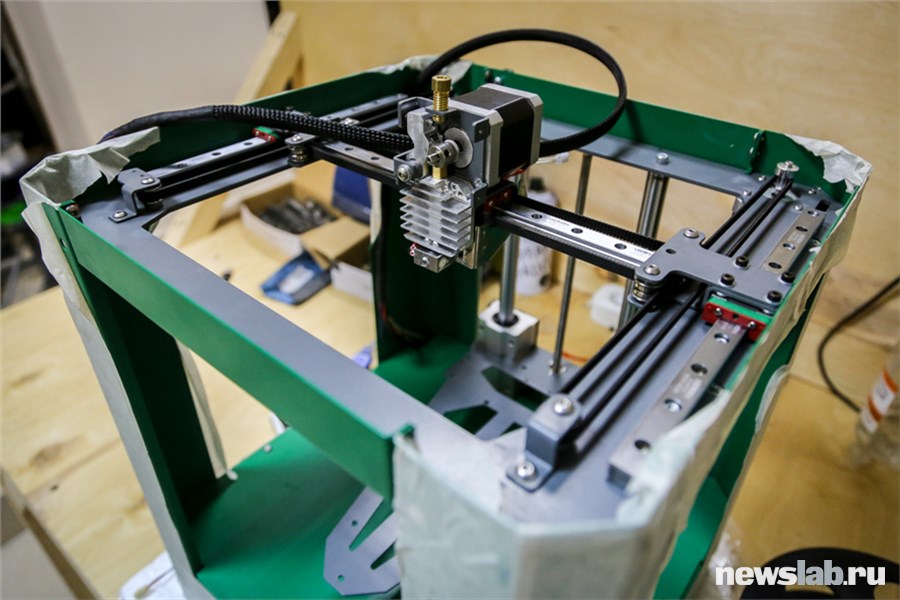 In loose terms technology used here is slicing CAD model of part geometry in layers using software and producing one layer at a time. Each layer sticks to previous layer and thus building the whole solid part in layers.
In loose terms technology used here is slicing CAD model of part geometry in layers using software and producing one layer at a time. Each layer sticks to previous layer and thus building the whole solid part in layers.
What technology is used in 3D printing?
Over the last few years, high-resolution 3D printers have become more affordable, easier to use, and more reliable. As a result, 3D printing technology is now accessible to more businesses, but choosing between the various competing 3D printing solutions can be difficult.
Which technology is suitable for your application? What materials and equipment’s are available to get started? How about costs and return on investment?
There are three most established plastic 3D printing technologies for plastic: fused deposition modeling (FDM), stereolithography (SLA), and selective laser sintering (SLS).
How many types of 3D printing are there?
There are 7 different types of 3D printing formulated by ASTM International officially in the ISO/ASTM 52900 standard:
- Material extrusion
- Material jetting
- Binder jetting
- Sheet lamination
- Vat photopolymerization
- Powder bed fusion
- Directed energy deposition
What materials can be used in 3d printing?
Plastics are the most widely adopted 3D printed material - and it comes in filament, resin, granule, and powder forms. Most thermoplastic 3D printing materials can be used in home 3D printing technology and professional applications as well. Below materials are also used widely:
Most thermoplastic 3D printing materials can be used in home 3D printing technology and professional applications as well. Below materials are also used widely:
- Acrylonitrile Butadiene Styrene (ABS)
- Polylactic Acid (PLA)
- Polyvinyl Alcohol (PVA)
- Nylon
- High-density polyethylene (HDPE)
What could an industrial 3D printer do for you?
Help Us Understand Your Needs
Get your quote now
review, photos, testimonials - Era-3D
Whether for functional prototypes, tooling or final products, PRO is offered with a number of new features, including a state-of-the-art software-controlled servo drive system from Bosch, new Metering Extruder (MXT) technology , a closed build chamber and temperature-controlled microclimate boxes for plastic filament spools.
The PRO printer was inspired by ONE and STUDIO 3D printers, winners of numerous awards including the German Brand Award 2018, the German Innovation Award 2018 and the German Design Award 2016.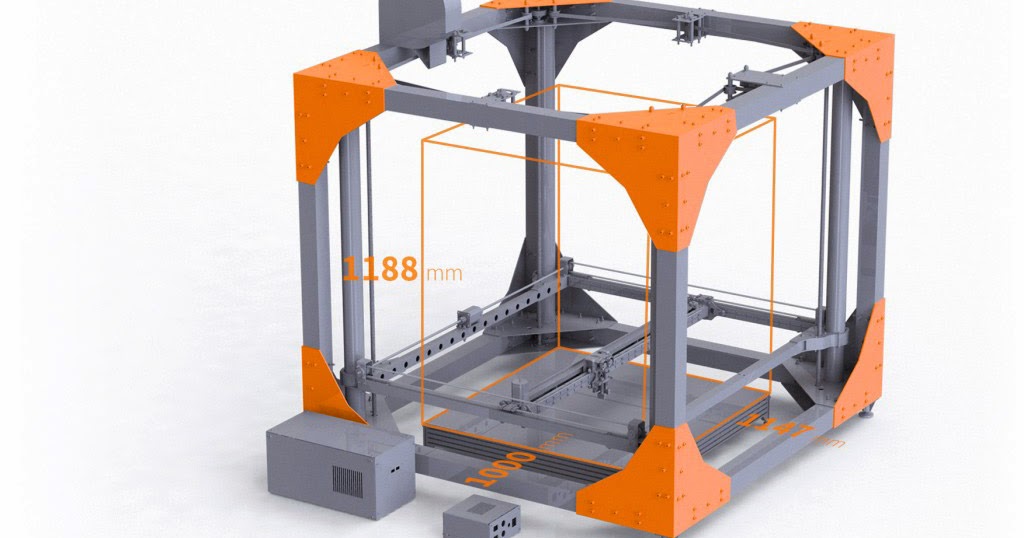
BUILDING PLATFORM
Large Scale Print Objects
True to its name, BigRep makes machines for large prints and PRO is no exception. The machine has a closed chamber of one cubic meter, designed for 3D printing of large-scale industrial objects, which allows for numerous applications in the industry.
CLOSED FRAME
Secure Seal
The insulated, closed metal frame ensures optimum even temperature control, while the glass doors provide optimum print visibility. Further enhancing safety is the PRO's compatibility with standard ventilation systems, fumes and emissions control, making it an example for industrial 3D printing.
ENVIRONMENTAL FILAMENT BOXES Compatibility with engineering media
PRO provides an optimal environment for engineering media printing with temperature and humidity controlled climate cabinets. Air circulation fans within provide airflow for an even temperature in the filament box, and it stores up to four spools of filament. nine0003
nine0003
MXT TECHNOLOGY
Speed & Accuracy
BigRep introduces metered extruder technology (MXT) with exceptional speed and precision, one of the defining features of PRO. This state-of-the-art extruder allows full control of material exit from the nozzle, providing the user with the highest print quality for every application.
BUILDING PLATFORM
Semi-automatic leveling
Heated build platform mounted with polyamide film ensures optimum adhesion during printing. The built-in inductive sensor allows semi-automatic leveling of the platform.
HIGH PRECISION CNC SERVO DRIVE SYSTEM
Bosch Rexroth Technology
The new advanced Bosch CNC drive control system makes the PRO the ideal machine to control the entire printing process, from start to finish. Widely used in the automotive industry, the Bosch CNC drive system provides maximum sensitivity, precision and closed-loop control in the BigRep industrial grade device, as well as excellent compatibility.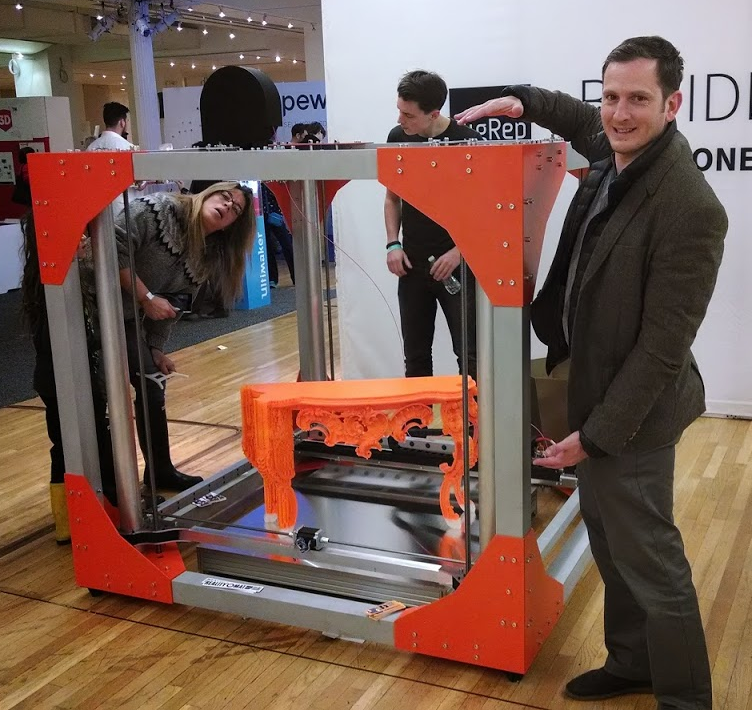 nine0003
nine0003
BigRep One 3D printer "prints" large objects
- home
- Market
- Technologies
13.03.2014Author Nikolai Blinkov
The 3D printer has the shape of a cube with a side of 1.5 meters and weighs almost 200 kg. BigRep One can print objects with dimensions up to 1147x1000x1188 mm (that's about 1.3 cubic meters)...
Modern 3D printers are most often small in size and can create objects that are quite small. To create something big, you have to create such an object in parts and connect them in one way or another. This fact complicates the use of 3-D printers in a number of areas. However, the situation may change with the advent of the BigRep One printer, developed by German engineers from the BigRep company.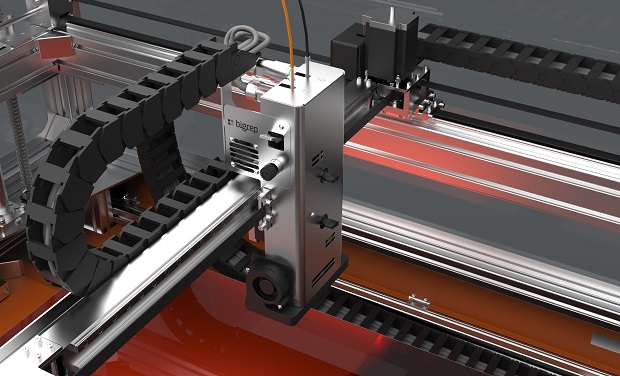 They created the largest mass-produced 3D printer to date. nine0003
They created the largest mass-produced 3D printer to date. nine0003
The device has the shape of a cube with a side of 1.5 meters and weighs almost 200 kg. BigRep One can print objects with dimensions up to 1147x1000x1188 mm (that's about 1.3 cubic meters). With it, you can "print" furniture, sculptures, as well as prototype parts for production in a particular area.
BigRep One can create objects from both ordinary plastics and specially designed materials such as laywood (mixtures of wood fibers and polymers) and laybrick (sandstone-effect fiber). The object is formed by layer-by-layer imposition of molten fibers of the working material (Fused Deposition Modeling, FDM). nine0003
The printer is based on an aluminum construction. The print resolution, despite the huge size of the printer, can be up to 0.1 mm, which is not inferior to conventional, more miniature 3D printers.
The giant's hefty price tag (approximately $39,000, delivery expected late spring) means that the average person is unlikely to buy it for home use.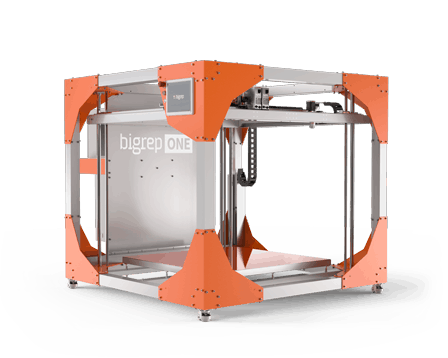 But it can be useful, for example, to small furniture workshops.
But it can be useful, for example, to small furniture workshops.
IT News magazine [No. 04/2014] Journal subscription nine0003
3D Printing
Previous
WiFi Surveillance Is Coming
Next
Boeing Black: A Smartphone for Intelligence and Diplomats
Want to be the first to know about new content?
Subscribe to the newsletter
news feed
Highlights of the week
By clicking on the button, I accept the terms of the agreement.
Related articles
Created a device that turns empty plastic bottles into 3D printer filament
The user puts an empty bottle into the Polyformer, the device shreds the plastic, heats it up and draws it into a thread. About 33 bottles are required per 1 kg of thread...
Olga BlinkovaTekhnologii, 06/20/22
Koroleva, together with Tomsk Polytechnic University and Tomsk State University, have developed a 3D printer to work on Me..
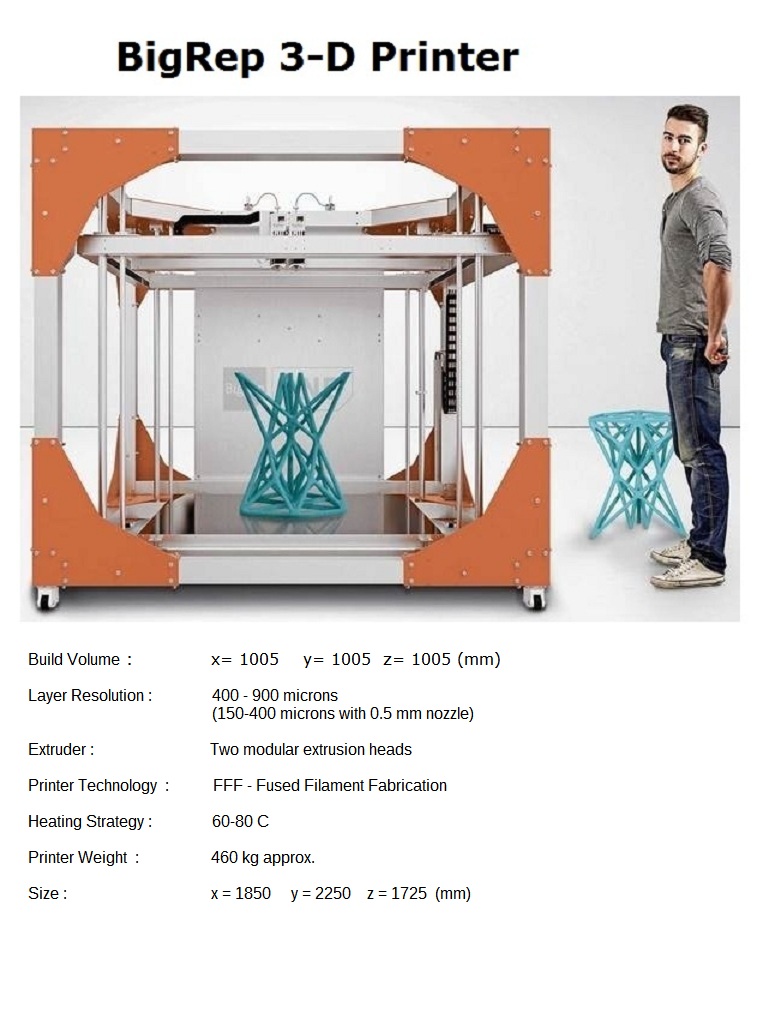 .
. Petr ChachinTechnology, 07.05.22
AnkerMake M5 "smart" 3D printer prints 5 times faster than competitors
The machine's standard print speed is 250 mm/s.
Anker InnovationsNews, 04/06/22
3D printing market against the backdrop of the pandemic (part III)
3D pens as a separate product segment appeared a long time ago, but it seems that this direction lives its own, separate from...
Evgeny KuryshevTrends, 07/20/21
Load more1 2 3 four five »» Next →
01:44
China planned to invest $145 billion in its chip industry, but the truth came out
18:59
ROBIN in the growing RPA market
18:00
In the new season of Tanks Blitz, players will have to fight with the CPU
15:48
GameRock is alive, and I?
12:24
Ada Lovelace comes out of the shadows
14:53
EMM systems in mobile development: what are they and what businesses need them?
10:43
Seven mistakes when switching to Russian office software
10:21
Free or paid trading software, what to choose? nine0003
14:00
Centers (16.